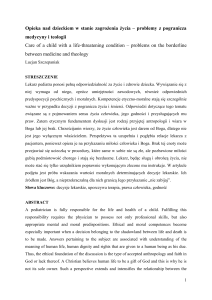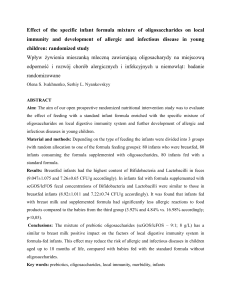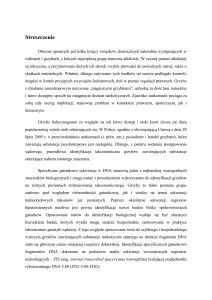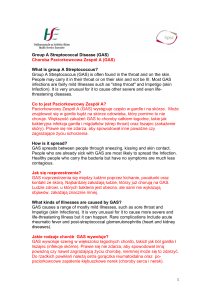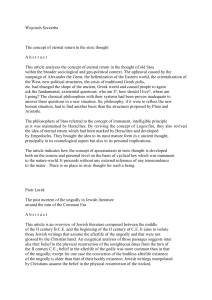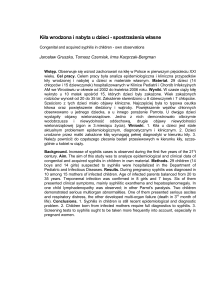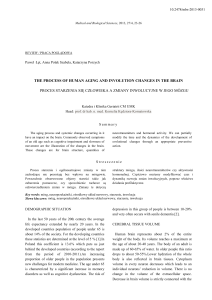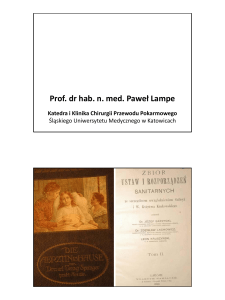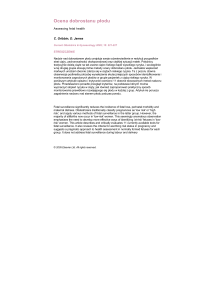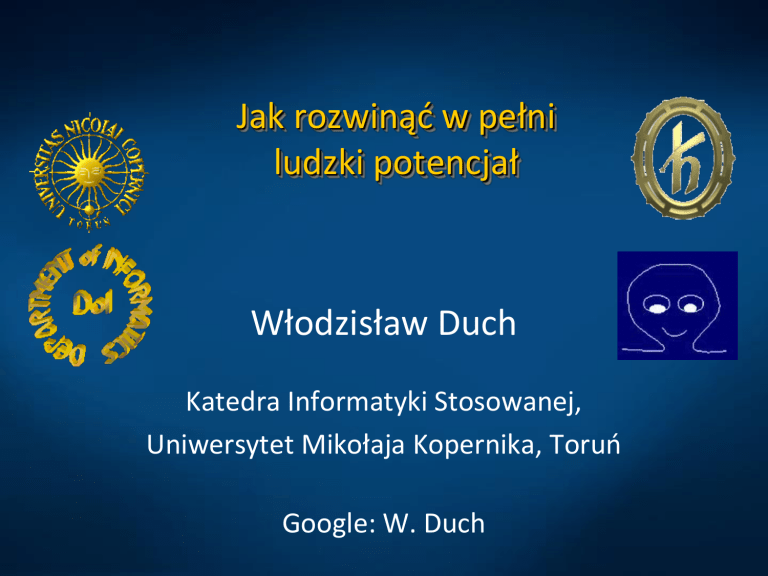
Jak rozwinąć w pełni
ludzki potencjał
Włodzisław Duch
Katedra Informatyki Stosowanej,
Uniwersytet Mikołaja Kopernika, Toruń
Google: W. Duch
Plan
Kilka rzeczy, które wiemy o wczesnym rozwoju dziecka
• Rozwój mózgu
• Rozrost kory
• Od czego zależy inteligencja
• Jak mierzyć inteligencję
• Potencjały ERP i czytanie
Doskonalenie mózgów
• Udoskonalenie mózgu to największe wyzwanie nauki i techniki.
Ostrożnie!
• Ogólna zasada: ciągła specjalizacja w upływem lat, ograniczanie
potencjalnych możliwości. Jak tego uniknąć?
• Geny określają jedynie z grubsza w którym kierunku mają zmierzać
aksony neuronów (np: od oka do kory wzrokowej, po drugiej stornie
mózgu) więc tworzy się za dużo neuronów a te, które nie są
używane szybko umierają (apoptoza).
• Geny mogą określać granice indywidualnego rozwoju ale te
granice są trudne do osiągnięcia.
• Manipulacje genetyczne są niebezpieczne.
• Wczesny okres jest krytyczny dla ukierunkowania rozwoju mózgu.
• Wyzwanie: zapobieganie problemom rozwojowym i wspomaganie
normalnego rozwoju.
• Maksymalna liczba neuronów tuż przed urodzeniem, ale połączeń
w wieku 3 lat, po czym gęstość połączeń spada do połowy.
Rozwój mózgu
Mózg rozwija się w różnych okresach życia w różnym tempie :
• Zmiany anatomiczne
• Grubość warstw kory
• Stosunek ilości materii szarej do białej
• Gęstość synaptyczna w różnych warstwach i obszarach
• Różne typy neuronów i ich połączeń rozwijają się w różnym
tempie.
• Integracja pracy różnych obszarów
umożliwia bardziej złożone formy
przetwarzania informacji w
sprawny sposób.
Inwestycje się zwracają
Najbardziej te w okresie najwcześniejszym … wczesne uczenie i
sukcesy zachęcają do dalszego uczenia i dalszych sukcesów.
Rozwój mózgu
Po narodzeniu ponad milion połączeń w ciągu sekundy!
Synaptogeneza
Dane są nadal kontrowersyjne, dla hipokampa:
Synaptogeneza
Dane są nadal kontrowersyjne, dla hipokampa:
Synaptogeneza
Gęstość synaptyczna
Szybki wzrost a potem przycinanie, nawet kora przedczołowa ma
największą gęstość połączeń już w 4 roku życia.
Objętość kory po narodzeniu
Grubość kory
Regiony odpowiedzialne za złożone czynności rozwijają się
wolniej, za ruch i analizę sygnałów zmysłowych szybciej.
Ogranicza to wielkość mózgu w czasie narodzin.
Zmiana grubości kory, 5 -11 rok.
Średnia zmiana grubości kory w mm, widoczny przyrost w
obszarach czołowych i skroniowych, oraz ubytek w
ciemieniowych i potylicznych.
E.R. Sowell, Trends Neurosci. 2006 March; 29(3): 148–159.
Zmiana grubości kory
• Czerwone: grubsza, niebieskie: cieńsza.
• Całkowita objętość wzrasta.
• Biała materia ciągle powiększa objętość, szara wzrasta i się
kurczy.
E.R. Sowell, J Neuroscience, 2005
Wzrost kory
• Czerwone: grubsza, niebieskie: cieńsza.
• Całkowita objętość wzrasta.
• Biała materia ciągle powiększa objętość, szara wzrasta i się
kurczy.
E.R. Sowell, J Neuroscience, 2005
Wzrost wielkości kory
• Rozwój kory po narodzinach, powiększenie u osoby dorosłej w
stosunku do wielkości po porodzie.
Evo-Devo
A: zmiana
wielkości w
stosunku do
makaka, żólte
obszary są 32x
większe.
B:
Podsumowanie
zmian
rozwojowych
od dzieciństwa,
żólte są 4 x
większe.
• Ewolucja i rozwój pokazują korelacje w obszarach skroniowych.
Rozwój kory
Rozwój kory
Długość snu
Po skończeniu dwóch lat dzieci dość szybko skraca się czas snu.
Brak snu
Skrócenie snu o godzinę w ciągu 7 dniu zmienia dramatycznie
reakcję mózgu (słuchowe potencjały ERP) na słyszane słowa
(Sleep Restriction Affects Children's Speech, 2007)
Brak snu
Experts recommend that children in pre-school sleep between 1113 hours a night, and school-aged children between 10-11 hours.
Your child should follow these steps to get a good night's sleep:
•
•
•
•
Follow a consistent bedtime routine.
Establish a relaxing setting at bedtime.
Get a full night's sleep every night.
Avoid foods or drinks that contain caffeine, as well as any
medicine that has a stimulant, prior to bedtime.
• Do not go to bed hungry, but don't eat a big meal before
bedtime either.
• The bedroom should be quiet, dark and a little bit cool.
• Get up at the same time every morning.
Czytanie: rozproszone procesy
Co widzą niemowlęta?
Czas patrzenia w %
paski: młodsze;
białe: starsze niemowlaki.
Twarze patrzące na nie
ostre kontury, kształty o
dużym kontraście
4 miesiące – odróżniają
kolory jak dorośli.
Ostrość widzenia (Snellen)
20/600 po narodzeniu
20/100 po 6 miesiącach
20/20 po 12 (normalna
ostrość widzenia)
Gdzie patrzą?
Kontrola ruchów sakadycznych gałek ocznych jest już precyzyjna po
dwóch miesiącach, widzenie głębi w 3-6 miesiąca.
Poczucie bezpieczeństwa
Neurocepcja: nieświadoma ocena zagrożenia (S.W. Porgess,
Neuroception. A Subconscious. System for. Detecting Threats and
Safety. 2004)
• Bezpieczeństwo – zaangażowanie w relacje z opiekunami,
rozwój zdolności emocjonalnych i poznawczych.
• Zagrożenie: ucieczka, bezruch lub walka
• Ucieczka nie jest możliwa, pozostaje bezruch: zamrożenie,
wycofanie, dysocjacje
• Walka: mobilizacja, nadmierne
pobudzenie, stres,
opóźniony rozwój organizmu.
Nerw błędny: regulacja serca,
oddechu, ssania, wokalizacji …
Bezdech i bradykardia.
Zaangażowanie niemowląt
The Social Engagement System is an emergent neurophysiological system
that phylogenetically developed to regulate contact with the external
world and to modulate physiological and behavioral state.
As the infant matures, the Social Engagement System shifts from a
reflexive brainstem system, to a system under cortical control with an
ability to initiate social behavior.
RSA, a measure of vagal regulation measured in infants, is related to
developmental outcome and especially to behavioral and psychological
processes associated with social behavior, ingestion, and state
regulation.
• Fussy-difficult infants, who by definition have state regulation
problems and excessive bouts of crying, have atypical vagal regulation
that may deprive them from the soothing effects of feeding.
Zaangażowanie niemowląt
During the first 6-months of life the measurement of vagal
regulation during feeding provides an early marker of the
developmental status of the neural platform for social behavior.
During the first year of life, cortical pathways develop that regulate
the striated muscles of the face and head and the vagus continue
to myelinate to form an integrated social engagement system - the
same circuits involved in feeding (ingestion) and state regulation.
As the infant matures, social context displaces feeding as the most
important regulator of behavioral state.
Problemy rozwojowe
• Jako najbardziej złożony organ mózg psuje się najczęściej.
• 5-10% dzieci ma problemy rozwojowe, które opóźniają prawidłowy
rozwój słuchu, mowy i posługiwania się językiem.
• Jeśli poważne problemy ze słuchem pozostają niewykryte w
pierwszych 6 miesiącach i nie podjęta zostanie terapia uzyskanie
pełnej sprawności w posługiwaniu językiem będzie
nieprawdopodobne. Średni czas identyfikacji wrodzonych wad
słuchu do niedawna wynosił 2.5 roku w USA i innych krajach, teraz
badania przesiewowe skróciły to do kilku miesięcy.
• Wczesne wykrycie problemów ze słuchem pozwala na osiągnięcie
normalnych kompetencji językowych.
• British Dyslexia Association ocenia, że 10% dzieci cierpi na jakąś
formę dysleksji a około 4% ma poważne zaburzenia opóźniające ich
rozwój w szkole.
NRC report
Committee on Integrating the Science of Early Childhood
Development, US National Research Council 2000 report:
“From Neurons to Neighborhoods: The Science of
Early Childhood Development”.
http://newton.nap.edu/catalog/9824.html?onpi_newsdoc100300
There is little scientific evidence that special “stimulation” activities
above and beyond normal growth-promoting experiences lead to
“advanced” brain “advanced” brain development in early childhood.
Early experiences clearly influence brain development brain
development, but a disproportionate focus on birth to three begins too
late and ends too soon. The early childhood years lay a foundation that
influences the effectiveness of all subsequent education efforts
Early intervention programs can improve the odds for vulnerable
children, but are rarely simple, inexpensive, or easy to implement.
NLNC
• Early in development, learners commit the brain’s
neural networks to patterns that reflect natural language input.
• Initial coding of native-language patterns eventually interferes with
the learning of new patterns (such as those of a new language),
because they do not conform to the established “mental filter.”
• Early learning promotes future learning that conforms to and builds
on the patterns already learned, but limits future learning of
patterns that do not conform to the ones already learned.
• MEG support: processing foreign-language speech sounds the
adult brain is activated for longer and over a larger area than when
processing native-language sounds.
• Training with appropriate phonetic materials improves behavioral
performance and increases neural efficiency, though not to the
native speaker’s level; interactive training is much more effective.
• At 9 months infants exposed to a new language learn phonetically
after only 12 exposure sessions during one month.
ERP and reading
• Can the hearing and speech problems be eliminated, improving
perceptual and cognitive skills of babies at the same time?
Poland – national program screening infant hearing (WOSP,2008).
Rozwój: podsumowanie
• Potrzebna jest jak najwcześniejsza interwencja.
• Działanie mózgu zależy od genetycznego fenotypu, ale
zmodyfikowane jest przez środowisko i uczenie.
• W pierwszym dwóch życia rozwój mózgu jest bardzo szybki,
synaptogeneza i apoptoza zmienia strukturę mózgu, powstają
nowe neurony (koło 18 miesiąca proces ten zanika) migrujące do
kory przedczołowej, nie działa więc pamięć robocza.
• Sytuacja jest niestabilna i wrażliwa na zewnętrzną regulację.
• Konieczne są symbiotyczne relacje z opiekunami dzięki stymulacji
dotykowej, wokalizacjom, ruchom ciała, oczu i wyrazom twarzy.
• Prawidłowe relacje umożliwiają samoregulację kształtując ścieżki
dalszego rozwoju, odczytywanie intencji.
• Nowe ścieżki neuronalnych pobudzeń pozwalają na
rozpoznawanie wzorców zachowań i nadanie im behawioralnego
sensu prowadzącego do zmniejszenia stresu wynikającego z
nieprzewidywalnego zachowania środowiska.
Równowaga biochemiczna
• Niepewność, strach => aktywacja ciała migdałowatego =>
aktywacja szlaku HPA:
podwzgórze, wydzielanie kortykotropiny (CRT) => aktywacja
przysadki i ACTH => kortyzol wydzielany z nadnerczy =>
neurotransmitery (adrenalina, noradrenalina, dopamina).
• Receptory kortyzolu wewnątrz komórek regulują podział komórek,
ich metabolizm i wpływa na reakcje immunologiczne.
• Krótkoterminowo: kortyzol zwiększa poziom cukru we krwi,
zwiększa koncentrację receptorów kortyzolu, wspomaga uczenie
zwiększając plastyczność mózgu w hipokampie i ciele
migdałowatym (pamięć nieprzyjemnych zdarzeń).
• Czemu lubimy się bać? W ten sposób uczymy się większej
elastyczności reakcji organizmu! Byle nie za długo …
• Długoterminowo: nadprodukcja kortyzolu, hipermetabolizm mózgu,
przewlekły stres, osłabienie układu odpornościowego i wzrostu.
• Wysoki poziom oksytocyny, będący wynikiem empatycznych relacji
symbiotycznych zmniejsza pobudliwość reakcji stresowych walkaucieczka, pomaga w regulacji reakcji afektywnych.
Oksytocyna
Wysoki poziom oksytocyny, zmniejsza pobudliwość ciała
migdałowatego przy oglądaniu nowych twarzy i scen.
Uczenie się
Początkowy etap:
• Powolne.
• Nieprecyzyjnie skoordynowane czasowo.
• Rozległe aktywacje mózgu, ale niestabilne, mało powtarzalne.
Pośredni etap:
• Poprawa synchronizacji i stabilności.
• Redukcja aktywności nieprzydatnych obszarów.
Dojrzałe, etap eksperta:
• Dalsza redukcja aktywacji.
• Stabilne aktywacje przestrzenno-czasowe.
• Większa szybkość.
• Elastyczność organizacji funkcji – specjalizacja jest tylko
częściowa, możliwe jest zastąpienie zajętych obszarów przez inne,
odmienna organizacja pracy mózgu może dać ten sam efekt.
Rozwój poznawczy
Początkowe proste możliwości obejmują:
• odruchy – ssania, łapania, grymasy twarzy;
• wrodzone preferencje, np. smaku i zapachu;
• orientacja, szukanie sutka;
• habituacja do powtarzających się bodźców dotykowych,
słuchowych, wzrokowych;
• imitacja – wysuwanie języka, wydymanie ust, otwieranie i
zamykanie dłoni i ust, już w pierwszych tygodniach życia.
Bardzie złożone możliwości:
• pamięć, początkowo rzędu jednej doby;
• preferencje powtarzających się wrażeń, stanów, widoków,
obrazów, dźwięków;
• zainteresowanie twarzami, interakcją z ludźmi;
• zainteresowanie niespodziewanymi sytuacjami – mózgi szybko
uczą się przewidywać.
Uczenie się: podsumowanie
• Potrzebna jest jak najwcześniejsza interwencja.
• Działanie mózgu zależy od genetycznego fenotypu, ale
zmodyfikowane jest przez środowisko i uczenie.
• W pierwszych latach życia rozwój mózg jest bardzo szybki,
neurogeneza (głównie migracja do przedczołowych obszarów)
synaptogeneza i apoptoza, relacje symbiotyczne z opiekunami.
• Indywidualne różnice mają wpływ na sposób reakcji na czynniki
środowiskowe i wewnętrzne.
• Różna organizacja na poziomie neuronalnym może prowadzić do
podobnych wzorców behawioralnych.
• Przetwarzanie bodźców zmysłowych warunkuje rozwój
kompetencji poznawczych i na odwrót, nie ma tu liniowej
przyczynowości.
• Nauka nowych umiejętności zmienia organizację pracy mózgu
wpływając na odmienne zaangażowanie różnych obszarów mózgu
w czynności poznawcze.
• Zmienia to szybkość, sprawność i złożoność dostępnych funkcji.
Inteligencja
Rozkład wokół średniej:
• W przybliżeniu rozkład Gaussa o średniej 100 i wariancji 15,
są duże odchylenia od średniej.
• Ok. 2/3 osób w rozkładzie Gaussa ma IQ w przedziale [85,115], a
96% w przedziale [70,130], a wiec 1/6 ma IQ powyżej 115 a 2%
powyżej 130.
• Średnia co pokolenie może zwiększyć się nawet o 10 punktów jest to efekt Flynna, który wynika prawdopodobnie zarówno z
poprawy warunków zdrowotnych, lepszego odżywiania,
bogatszego środowiska
(np. zabawek) i wychowania
dzieci rozbudzającego aktywność
intelektualną.
• Wśród najbardziej inteligentnych
ludzi przeważają obecnie Azjaci
(dla IQ>200 prawie wyłącznie).
Rodzaje inteligencji
• IQ mierzy inteligencję racjonalną.
• IQ>120 nie zwiększa szansy na sukces życiowy.
Howard Gardner rozwinął teorię inteligencji wielorakiej, wyróżniającą
8 głównych aspektów funkcjonowania:
1. językową, zdolności komunikacyjno-oratorskie;
2. matematyczno-logiczną, pojęcia abstrakcyjne;
3. wizualno-przestrzenną, orientacja, wyobraźnią wzrokowa;
4. muzyczna;
5. interpersonalną, rozpoznawanie uczuć i intencji ludzi, empatia;
6. intrapersonalną, rozumieniem samego siebie;
7. cielesno-kinestetyczną;
8. przyrodniczą (ekologiczną)
• Daniel Goleman wprowadził pojęcie inteligencji emocjonalnej,
• Inteligencja duchowa, zdolność do integracji informacji i
nadawania im uogólniającego sensu.
Długotrwałe badania
Od narodzin co roku w okolicach urodzin dzieci były testowane
Zbierano informacje o sytuacji rodzinnej i zdrowiu dzieci.
Czytanie i umiejętności językowe wymagają:
• Dokładnego rozpoznawania fonemów;
• Połączenia grafemów (symboli graficznych) i fonemów
• Rozpoznawania symboli jako ciągu fonemów
• Szybkiego przetwarzania
Jak wcześnie ujawniają się różnice?
Badano niemowlaki < 36 godzin po narodzeniu.
Bodźce: sylaby bi, di, gi; bae, dae, gae; bu, du, gu, odgrywane
przypadkowo.
Czytanie w późniejszym okresie: różnice w rozpoznawaniu wyrazów
sięgają pół sekundy, rozpoznawanie jest niestabilne, wymagające
wysiłku, w końcu prawidłowo rozpoznane ale powoli, co wpływa na
płynność i rozumienie słyszanego i czytanego tekstu.
Długotrwałe badania
Dzieci o średnich lub wyższych wynikach w testach werbalnego
zrozumienia w wieku 3 lat. Przykładowy wynik:
Długotrwałe badania
Dzieci o słabszych wynikach w testach werbalnego zrozumienia w
wieku 3 lat. Przykładowy wynik:
Przewidywania
Reakcje niemowląt pozwalają przewidzieć wyniki testów 8-latków w
czytaniu. Testy: Wechsler Intelligence Scale for Children (WISC) Full
Scale IQ (FSIQ) oraz Wide Range Achievement Test (WRAT)
Reakcje niemowląt
zagrożonych
problemami na
fonemy są o 200
ms późniejsze niż
u pozostałych.
Dokładność
przewidywań jest
rzędu 80%.
20% miało
szczęście lepiej się
rozwinąć?
Wyniki dla 8-latków
Przetwarzanie sygnałów mowy jest około 100 ms wolniejsze u dzieci
słabo wypadających w testach – to zostawia 100 ms na sylabę na
inne procesy.
Zrozumienie: szybki i
wyraźny sygnał, szybkie
zakończenie
przetwarzania i propagacja
aktywacji fonologicznej do
innych obszarów mózgu.
Jakie długości i amplitudy?
Trudno znormalizować
amplitudę?
ERP w różnym wieku
Zrozumienie:
szybki i wyraźny
sygnał, szybkie
zakończenie
przetwarzania i
propagacja
aktywacji
fonologicznej do
innych obszarów
mózgu.
Jakie długości i
amplitudy?
Trudno
znormalizować
amplitudę?
ERP w różnym wieku
Zrozumienie:
szybki i wyraźny
sygnał, szybkie
zakończenie
przetwarzania i
propagacja
aktywacji
fonologicznej do
innych obszarów
mózgu.
Zmiany latencji
Czas pojawienie się
pierwszego załomka
ujemnego N1 i
dodatniego P2
skraca się z wiekiem
ale są różnice dla
osob o równych
wynikach w testach
VCIQ (verbal
comprehension IQ).
Różnice się
powiększają, więc
dokładność
przewidywań
zwiększa się z
wiekiem.
Amplitudy
Wyniki dla 3 elektrod,
F4, C4, P4,
dzieci z grupy ryzyka i
kontrolnej różnią się
średnimi amplitudami
ERP, szczególnie P4
jest wyraźnie słabsze.
Amplitudy
Wyniki dla 6 elektrod, F3 i
F4, C3 i C4, P3 i 4,
dzieci z grupy ryzyka i
kontrolnej różnią się
średnimi amplitudami ERP,
szczególnie w prawej półkuli
jest wyraźnie słabsza
aktywacja.
6 miesięcy, reakcja na sylaby
Wyniki dla 6 elektrod, F3
i F4, C3 i C4, P3 i 4,
dzieci z grupy ryzyka i
kontrolnej różnią się
średnimi amplitudami
ERP, szczególnie w
prawej półkuli jest
wyraźnie słabsza
aktywacja.
6 miesięcy, reakcja na sylaby
Reakcje na sylaby ba/ga/da w 3–5 dniu życia wykazują różnice u
dzieci z grupy ryzyka i kontrolnej. Wyliczone stąd współczynniki
służądo przewidywania problemów z czytaniem.
Guttorm et al. (2005), Lyttinen et al. (2009).
Dyskryminacja słowo/nie
Dzieci w wieku 9-12 lat, w teście odróżniania czy słyszane słowo ma
sens czy tylko jest podobne; silne P300 wskazuje na długi czas decyzji.
Słownictwo
Matki mówiące więcej do swoich dzieci maja wielki wpływ na
przyswajanie sobie nowych wyrazów.
Słownictwo
Matki mówiące więcej do swoich dzieci maja wielki wpływ na
przyswajanie sobie nowych wyrazów.
ERP and speech
D.L. Molfese used auditory event-related potentials
recorded at birth to speech and nonspeech syllables.
Predictions based on ERPS: dyslexic, poor, or normal readers 8 years
later (2nd grade), with 82% accuracy.
=> reading problems can be identified and possible interventions
undertaken up to 9 years earlier than is currently possible.
Can this be changed?
ERP for high school students learning names for different countries as
indicated after a 15 minute period how successful these students will be
in learning to associate names with the outlines of different countries.
ERPs allow for prediction when the material was mastered versus when
students were only familiar with the material but had not yet mastered it.
The field ...
• So far mainly developmental psychology.
• Alison Gopnik, Andrew Meltzoff, Patricia Kuhl (1999)
The scientist in the crib: What early learning tells us
about the mind. HarperCollins
• P.W. Jusczyk (1997) The discovery of spoken language.
Cambridge, MA: MIT Press.
• De Boysson-Bardies B. (1999) How Language Comes to
Children. MIT Press
and many others ...
• Other relevant fields: neuroscience, genetics,
behavioral psychology, learning sciences ...
Physical development
Techniques
• Preferential looking using Fantz looking chamber.
which of the two stimuli is attended longer?
• The (dis)habituation method: popular strategy for measuring
infant sensory and perceptual capabilities.
• HASP, High-Amplitude Sucking Paradigm: enables them to
control their sensory environment to some degree.
• Speech/sound recognition and body movement
detection, especially conditioned head-turn.
• Event-Related Potentials (ERPs) measure average change in the
EEG brain wave patterns time-locked to the onset of stimuli.
• Other imagining techniques: difficult for infants, rarely used.
Infant communication
• Brain is capable of learning, but poor sensory analysis and motor
coordination makes it difficult to communicate with infants.
• Some developmental psychologists recommend
pre-natal stimulation: BabyPlus™ “enhanced heartbeat”,
prenatal education system, playing music to babies in the womb.
Claims: prenatally stimulated children exhibit advanced skills:
longer attention spans, higher IQs and musical inclination.
• Playing tapes with foreign language lullabies and stories.
• All this is passive learning, much less effective than interactive
learning in which the infant is actively engaged.
Can one learn walking just by observation?
• Learning to perceive, speaking and drawing inferences should be
active, guided by well-structured inputs and positive feedback.
What do they feel?
•
•
•
•
•
•
•
•
Newborns distinguish various odors, like vinegar, alcohol …
Show disgust when odors are unpleasant.
May recognize their mothers by odor.
Recognize smell of mother’s milk, choosing pads with this milk over
others.
Show different responses to basic tastes, preferring sweet and
showing negative responses to other tastes.
Tactile stimulation leads t changes in heart rate and behavior.
Tactile exploration helps visual recognition (but not vv).
Sensitivity of the senses quickly improves with age.
What do they hear?
Hearing is well developed, although infants pay
attention only to a bit louder sounds (50-70 dB).
High-pitched feminine voices (motherese language)
are especially interesting to infants, they can distinguish mothers voice.
Infants discriminate phonemes from the beginning, by 2 month they
can distinguish vowels.
Strong evidence for critical periods in speech hearing development.
Middle ear inflammation, or Otitis Media (OM), is the most common
specifically treated childhood disease, prevalence 17-20% of Acute OM
within the first 2 years of life. OM is a major cause of hearing loss,
speech production problems, recurring infection linked to poor learning
and social skills.
From www.emedicine.com
Intermodal perception (integration of sensory information) is in place
already in 4-month old.
Sign language
• Linda Acredolo, Susan Goodwyn, Douglas Abrams,
Baby Signs: How to Talk with Your Baby Before Your
Baby Can Talk. McGraw-Hill (2002)
• Susan Goodwyn and Linda Acredolo, Baby Signs Complete
Starter Kit: Everything You Need to Get Started Signing With
Your Baby (2006) & many other books.
• Sign-language for communication with infants (US patent):
using simple signs with babies to bridge the gap between
understanding and speech development
• L. Acredelo (UC Davis) and S. Goldwyn (California State Univ):
babies who are taught signs to express themselves before they
can say speak are happier and more adept at speaking once they
begin to acquire language.
• Infants can learn over 100 signs, ex: fingers to the lips for eat,
fingers raised in a V for bunny, etc.
Speech perception facts
• Speech perception is based on syllables, combinations of
elementary phonemes; 2-month old recognize syllables.
• There are about 6800 languages, but only 800 phonemes.
• The ability to hear phonetic contrasts of all possible human
languages is in-born, 6 month old are still good in any language.
• This ability declines sharply 10 month after birth, only the ability to
distinguish contrast in languages that are spoken to the child is
preserved – one of the earliest specializations.
• At 5 month children are able to categorize a vowel in
a speaker-independent way.
• Learning many languages correlates positively with IQ
• Tonal languages, prevalent in Asia, are phonetically rich,
but even ‘simple’ /ra/-/la/ contrast is impossible for Japanese,
/vi/-/bi/ for Spanish, /s/-/th/ for most non-English native speakers.
Speech development
• Stages of speech development (perception and production) in the
first year of life (from Kuhl et al 2007).
Phonemes
Vowels spoken by 97
speakers, seen in the
first 2 formants only.
Mapping to the
auditory cortex looks
similar.
/p/ - /b/ requires < 10
ms discrimination.
Categorical
perception means
that what we hear
jumps from a to e with
no gradation in
between.
Try to hear Chinese
ma – ma difference!
la-ra contrast
Small step changes from la
to ra syllables is made
producing 15 sounds, from
pure la to pure ra.
The boundary is at 7, and
comparison is made
between sound pair
(k,k+4); Americans show
the peak across the
boundary, Japanese make
random guesses.
Discrimination of nonnative phonemes is perfect
in 6-8 month group but
vanishes between 10-12
month.
Try da-ga for yourself!
Phoneme discrimination
P. Kuhl et al (2005): is there a relation between speech perception
and language development?
• Parental education, profession and income level were not related
to either the infants’ early speech perception skills or later
language abilities.
• Early phonetic learning alters perception and changes future
learning abilities, but it has to be active! TV is not sufficient!
• The ability to discriminate two vowels in native-language at 6
months of age (measured by the head-turn conditioning task)
predicts language outcomes in typically developing infants at 3
ages over the next 18 months.
• Correlation between early speech perception skills and later
language abilities: better native-language discrimination at 7
months predicts accelerated later language abilities, whereas
better nonnative-language discrimination predicts reduced
language abilities.
• Theory (Kuhl): native language neural commitment (NLNC) or
dedicated neural networks that code the patterns of nativelanguage speech, enhances native-language learning.
Speech problems
• Up to 4 million primary and secondary school students in USA
have difficulty distinguishing between phonemes, particularly
between consonants like b, d and p; is it pee or bee, pun or bun?
• “Fast ForWord”® software by Scientific Learning helps to develop
learning skills for 5-7 year olds, using acoustically modified
speech; has been used by over 150.000 children in the USA.
In Poland: Centrum Audio-Psycho-Fonologii (not much in 2007).
• Private clinicians provide Fast ForWord training (>$2,500).
It shows remarkable success with kids who suffer from central
auditory processing disorder that leads to speech understanding
problems and retards reading.
• Big market: Learning Company, the producer of Reader Rabbit,
was acquired by Mattel for $3.5 billion.
• Can the hearing and speech problems be eliminated, improving
perceptual and cognitive skills of babies at the same time?
Poland – national program screening infant hearing (WOSP,2008).
Perfect Pitch
• Beethoven, Bach, Chopin, Handel, Mozart ...
Haifetz, Solti, Toscanini, Menuhin ... all had perfect pitch.
• In a study of 600 musicians (Baharloo et al 1998) it was found:
among those that started to learn music before 4 years 40%,
started after 9 only 3% had absolute pitch.
• Greater asymmetry of planum temporale ~ perfect pitch.
• Estimation in western population: 1 in 10.000 has perfect pitch.
• Programs to learn perfect pitch are not effective; some birds have
it (Takeuchi & Hulse 1993).
• Mandarin & Vietnamese speakers display precise and stable form
of absolute pitch in enunciating words (Deutsch et al 2004).
• The potential to acquire absolute pitch is universally present at
birth; it can be realized by enabling the infant to associate pitches
with verbal labels during the critical period for speech acquisition.
Motor development
• Duke University, NC, 2002: velcro-covered mittens help
2-3 month infants develop more quickly.
• Infants are no yet able to grasp objects, but velcro mittens help
them to catch and then touch toys;
this speeds up motor coordination and perceptual development.
• Babies who had experience with the mittens outperformed the
babies who didn't in a number of ways.
• Long-term consequences of this procedure are still investigated.
News shown by CNN and elsewhere: in this area it is easy to get
a free press ...
• Lynn-Flynn effect: IQ grows everywhere in the
world, 24 points in USA since 1918, 27 points in UK.
Toys and nutrition help to develop better brains?
Temperament
J. Kagan et al. developed a set of challenges for 4-mo-olds:
highly stimulating sounds, sights, and smells presented in
a set order. Some babies enjoy it, smiling and waving their
arms, some babies fuss and cry.
Tests at 2 months do not predict later temperament but
at 4 months there are correlations:
babies who react positively are more likely to become active toddlers,
those avoiding stimulation (~20%) are more likely to be fearful and shy.
=> Negative reactivity to novel stimuli as infants may evolve into a shy,
inhibited, anxious temperamental pattern by toddlerhood.
Infants who remained continuously inhibited displayed right frontal EEG
asymmetry as early as 9 months of age, while those who changed from
inhibited to noninhibited did not.
Group of infants selected at 4 months of age for patterns of behavior
thought to predict temperamental exuberance displayed a high degree of
continuity over time in these behaviors.
Abstract thinking
• G. Marcus et al, “Rule learning by seven-month-old infants”,
Science 1999, Vol. 283, pp. 77 – 80.
7-month old babies habituated for 2 minutes with sentences like
ga ti ga, li na li, of the ABA structure, recognize that wo fe wo has
correct grammatical structure but wo wo fe does not.
• Intelligence: speed of thinking + working memory + density of
neural connections reflected in ERP structure.
• Strong correlation of IQ between the ability to order two very short
sounds, one with higher pitch (ex. J. Drescher, UMK Torun).
• Lynn-Flynn effect: IQ grows everywhere in the
world, 24 points in USA since 1918, 27 points in UK.
Toys and nutrition help to develop better brains?
What we are up to ...
• Experiments with infants are mostly passive, little interaction, infants
had no control over their environment, no initiative.
• Permanent monitoring of babies in the crib: what can we learn?
• Challenging stimulation, perceptual problem solving, recording and
analysis of infant’s responses – boosting natural learning processes
by providing guidelines for perceptual and cognitive development.
• PerCog (Perception-Cognition) devices that actively respond to
infant’s activity: toys and environments.
• Identifying developmental problems before they become serious,
calling an expert help if needed.
• Preventing developmental problems by enhancing categorical
perception through training and increasing working memory.
• Scientific, medical and practical impact.
• Key sensors: suction response, motion detectors, auditory and
visual monitoring, simple visual and auditory stimulations.
Philips “Magic Mirror”
• Some companies are going in this direction, making interactive
toys, for example:
“Magic Mirror” introduced in 2003
Records and replays baby’s voice,
triggers first speech sounds and
has mirror, pushing buttons
produces some sounds,
encourages experimentation.
It is not aimed at enhancing
specific perceptual skills.
US5893720 abstract
Hannah R Cohen (US) 1999 patent:
A computer toy for infants that promotes normal speech development
by facilitating the infant's experimentation with babbles and other
elementary sounds. Additionally, the toy provides an enriched
environment for language learning by prompting the infant with a
repertoire of verbal sounds including phonemes, syllables, and simple
spoken words.
The toy includes a microphone input device for detecting vocalizations
by an infant and an audiovisual output device for providing feedback to
the infant including the immediate playback of the infant's own
vocalizations, and a control means for transforming detected
vocalizations into instructions for use by the audiovisual output device.
Philips “Magic Mirror” is based on this principle.
Active stimulator of brain’s speech centers,
especially infant and children
My old 1997 patent, granted in 2002:
Active stimulator of brain’s speech centers, especially infant and
children, with input device, analog-digital converter, memory
containing phonemic patterns, comparator of phonemes received
through inputs
and ofretrieved
from the memory, logical decision unit,
PWF, memory
the
phoneme prototypes
digital-analog
converter, and the
output device
for sound.
wzorców
D, decision logic
K, comparing
Phoneme
A/D-W
analog - digital
converter
F
F
The input device
connects to the analog-digital
this
F1 F
F1converter,
Microphone (input device)
converter is connected to one input
of the comparator, another input
F1
Phoneme
of the comparator
connects to the memory
containing phonemic
F2
G
D/A,
digital
–
analog
F1 or F2
converter, sounds
patterns, and theSpeaker
comparator’s
output is connected to a logical
decision unit; the output from this unit connects
with the sound
AV
visual signaling
device
producing device through the digital-analog
converter.
(positive feedback)
Total cognitive care
• Observe the baby and interpret his/her behavior by monitoring
vocalization, sucking response, movements, GSR etc.
• Challenge the baby to solve perceptual/abstract problems.
Use natural audio-visual-tactile stimulation.
• Reward behaviors that correlate with differences in stimuli.
For example, if a series of sounds is played:
“la la la la ra ra ra ra”, reaction to la-ra change shows that the
baby has noticed an important phonetic contrast.
• PerCog devices for enhancement and therapy of perceptual and
cognitive skills use intelligent AI control to model what the baby
has already learned, what and how often should be presented,
observing, diagnosing, correcting and teaching infants.
• Hypothesis: active learning should gently pressure baby’s brain to
develop perceptual/cognitive skills in the desired direction.
Toys for speech development
• Goal: enhance phonematic hearing.
• Prepare a database of phonemes and syllables, present pairs
that are similar, and if the infant notices phonetic contrasts, apply
positive stimulation. Start with basic contrasts, end with subtle.
Database
of
• The infant is not ableTelemetric
to repeat
speechreceiver
sounds:
changesspeech
in the
Wireless
sounds
A/D converter
communication
pacifier
larynx, highly sophisticated
control over vocal cords, are slower
than neural development.
la-la … la-ra-ra…
D/A converter
Control unit
sound sequences
RAM
Speaker
• Hypothesis:
Non-volatile
Database of
Audiovisual
memory
reward patterns
device (reward)
1) Early (~10 month) specialization
in correct discrimination
of
mother tongue phonetic contrast may be eliminated, giving the
baby ability to learn any language she/he chooses.
2) Sharper discrimination between basic phonemes should
prevent some hearing and speech problems.
Toys for musical ear
• Goal: enhance musical hearing, develop perfect pitch.
• Only one person in 10.000 has perfect pitch; adult professional
musicians try to learn it but it is very hard.
• Prepare a database of musical sounds of different instruments at
different pitch, present pairs of sound samples with few seconds
of silence in between, reward for signaling that sounds were of
the same pitch although tones may differ.
Start with pure frequencies, move to more complex sounds and
chords composed of several sounds.
• Hypothesis: memory for absolute sound pitch should develop,
increasing the ability to hear subtle musical structures.
Toys for autistic children
• Example - LINKX: a language toy for autistic toddlers.
• Such children have an excellent memory but also
have problems with learning meaning of words,
they need a lot of repetitions, feedback, and rewards.
• LINKX is based on pictograms with sound added to it, called
speech-o-grams; objects are labeled with patterns that produce
sounds (recorded by parents) after touching them with blocks.
• Linking blocks to a speech-o-grams plays sound and produces color
light; children repeat it over and over.
• More toys for children wit various disabilities are needed.
• Crib with connection to a speaking mother and sound correction
that filters various aspects of mother’s voice (Kulesza, ETI Gdansk).
Toys for abstract thinking
• Goal: enhance the ability to think!
• Infants habituated for 2 minutes with sentences like
ga ti ga, li na li, of the ABA structure, recognize that wo fe wo has
correct grammatical structure but wo wo fe does not.
G. Marcus et al, “Rule learning by seven-month-old infants”,
Science 1999, Vol. 283, pp. 77 – 80.
• Challenge the infant using sounds and color lights with structures
of increasing complexity, reward for noticing differences.
• Hypothesis: solving problems of this kind has strong influence on
development of the cortex, in particular frontal and temporal
areas, and should increase working memory span, that correlates
well with general IQ.
More PerCog devices
Goal: enhance perceptual discrimination in all modalities, improve
categorical perception, increase working memory span, long-term
perceptual memory, encourage abstractions and faster reactions.
Responses to stimuli, behavioral interaction patterns should allow for
early diagnosis of developmental problems.
Imagine ...
• A world in which people could communicate
without problems and even adults learn languages easily.
• A world in which developmental abnormalities related to speech
and reading would largely vanish.
• A world much more rich in subtle sensory experiences.
• A world in which the potential of each child would always fully
develop, and natural curiosity will grow ...
• We just have to start quite early, adding structure to the
development of the brain – in a natural, effortless way.
• This is possible with PerCog devices, such as cognitive toys!
• Guess what is the market for such devices?
Brave new world?
New generation of children may grow up to be:
•
much more intelligent than we are
•
think much faster than we do
•
be much more musical
•
be largely free of speech and hearing problems
•
be able to learn any language without accent
•
see and hear things we can hardly notice
Is this possible? Only research can tell.
So far
• Polish patent application was restricted to phoneme perception, the
present proposal is much wider and differs in important aspects.
• We have made some research assuming that the main feedback
from the infant will be via vocalization: phonemes from 28
languages have been collected, software to present them,
recognize change from silence/speech and vowel/consonant
change in baby’s vocalization has been used; this is done by
microphone and speaker connected to PC sound card.
• Sucking (HAS), head turning preference, visual fixation and other
procedures used by psychologists for infants < 6 month are better.
• Some work on hardware implementation has been done, but it still
requires a PC to analyze the data; hardware working prototype due
to technical problems.
Roadmap
• First personalized medicine device, not related to molecular level:
adapts to the individual needs/abilities.
• Patent application: “Devices for enhancement and therapy of
perceptual and cognitive skills of infants and children” for all kinds
of PerCog devices and total cognitive care of infants, forthcoming.
• Ready for more R&D and quick commercialization of speech
devices in the Far East, and prevention/diagnosis/treatment of
speech/reading problems in the rest of the world.
• Construction of PerCog devices in form of electronic toys or crib
environments, initially with a modest number of phonemes
covering basic phonetic contrasts, is not difficult.
• Computer games for babies and children may be created using
the same principle.
• Creating infant development lab in the ICNT at UMK.
KizdGrow (Singapore)
Research opportunities
• We need an interdisciplinary group including experts in
developmental psychology, phonetics, neurolinguistics,
speech/hearing/language pathologist, education experts, signal
processing, electronics (sensors + IC), toy design, software
development, data mining ...
• Creation of larger phonetic databases: most important phonetic
contrasts for major languages, syllables and words which are hard to
distinguish, like van/ban, thick/sick, extending it to cover subtle
differences, and finally full spectrum of speech sounds.
• Improvement of the feedback recognition systems: wireless sucking
monitoring devices, analysis of infant babbling for sounds that infants
may use for signaling, observation of movements.
• Follow-up studies to investigate the effect of using cognitive speech
toys on phonetic contrast perception (a few month), language
learning (long-term studies), reduction of speech and reading
abnormalities (long-term), general intelligence (abstract challenges).

